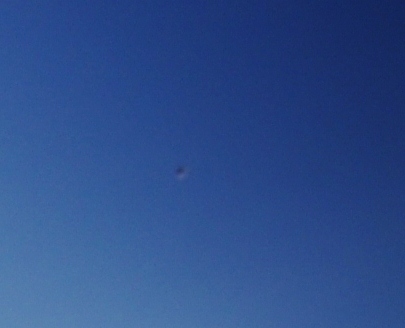It looks like you're using an Ad Blocker.
Please white-list or disable AboveTopSecret.com in your ad-blocking tool.
Thank you.
Some features of ATS will be disabled while you continue to use an ad-blocker.
share:
reply to post by westcoast
Great photograph Westcoast. Using a red filter will reveal even more going on around that planet too. Can't wait to show it to my family who glaze over whenever I mention Nibiru/Planet X.
Great photograph Westcoast. Using a red filter will reveal even more going on around that planet too. Can't wait to show it to my family who glaze over whenever I mention Nibiru/Planet X.
Just so you know you are not alone. Others have reported something very similar, check out here: www.chemtrailcentral.com... Did I
mention I live very close to you, Westcoast, and have noticed some VERY strange cloud formations and "contrails?"
reply to post by paddymelon
if it is "planet x" or "Nibiru" it is just sitting there.
Could be a camera issue from pointing it at the sun being amplified by the extreme brightness hitting various parts of the camera.
www.aquilaonline.co.za...
ETA: Hey look guys-
www.pentaxforums.com...
scroll down to the images, could this be what we are seeing here?
if it is "planet x" or "Nibiru" it is just sitting there.
Could be a camera issue from pointing it at the sun being amplified by the extreme brightness hitting various parts of the camera.
www.aquilaonline.co.za...
ETA: Hey look guys-
www.pentaxforums.com...
scroll down to the images, could this be what we are seeing here?
edit on 10-4-2012 by Malcher because: (no reason given)
Looks like a planet to me. That's pretty weird. I tell you, there is some crazy # going on.
A friend of mine, who gets off in the wee hours of the morning told me about what he saw the other morning.
According to him, now remember the sky was still relatively dark when he got off work, he and his friend were riding home and they happened to glance up at the sky. What they saw stunned them. He said there was a big black X marking the sky.
He relayed the message to me when I woke up later that morning. I found it rather peculiar, but I've been watching videos of some of the things that are going on, and there seems to be quite a few peculiar things occurring.
This halo occcurrence around the sun is rather unusual. Very few times in my life have I ever noticed such a thing, and if I did, it wasn't at the magnitude that it currently is. I watched a video where it almost looked as if there were a tunnel leading directly to the sun....Yeah, very odd.
A friend of mine, who gets off in the wee hours of the morning told me about what he saw the other morning.
According to him, now remember the sky was still relatively dark when he got off work, he and his friend were riding home and they happened to glance up at the sky. What they saw stunned them. He said there was a big black X marking the sky.
He relayed the message to me when I woke up later that morning. I found it rather peculiar, but I've been watching videos of some of the things that are going on, and there seems to be quite a few peculiar things occurring.
This halo occcurrence around the sun is rather unusual. Very few times in my life have I ever noticed such a thing, and if I did, it wasn't at the magnitude that it currently is. I watched a video where it almost looked as if there were a tunnel leading directly to the sun....Yeah, very odd.
edit on 10-4-2012 by SpeakerofTruth because: (no reason given)
reply to post by SpeakerofTruth
Atmospheric Optics as linked at least twice in this thread:
Specifically:
Sundogs
Beautiful, not mysterious once you know the science behind the phenomena.
Except for the Death Star...we'll be joining Alderaan soon.
Atmospheric Optics as linked at least twice in this thread:
Atmospheric Optics is the fancy name for light and colour in the atmosphere, such as rainbows, halos, shadows, and mirages. This page will try and explain in simple terms how these beautiful phenomena occur, and where and when to look for them. Many wonderful things go unnoticed every day simply from not knowing where to look. Along the way this site will branch out to related fields such as weather phenomena, and light outside the atmosphere - the heavens above
Specifically:
Sundogs
Parhelia or sundogs as they are more commonly known are caused by ice crystals in the atmosphere. They lie on the 22 degree halo either side of the sun.
Beautiful, not mysterious once you know the science behind the phenomena.
Except for the Death Star...we'll be joining Alderaan soon.
Whatever it is or is not, its still a nice picture westcoast. I actually saw this sundog the same morning after I dropped my son off at daycare and
joked to my self about taking a picture of it and making a joke how its a "second sun"
Go to 6:20 in this vid for something very similar to what is caught on wc pic.....only with NASA CAM!
reply to post by nitro67
Nitro, how do we know how old those images are in the beginning of the clip? Is it possible they can be fairly recent perhaps within the last few decades and from someones imagination like we see in movies?
As far as the op's object: can another candidate be a weather balloon?
www.google.com... UQ_AUoAQ&biw=1340&bih=978
Considering we have no idea the distance the object is in relation to the sun at all really.
Nitro, how do we know how old those images are in the beginning of the clip? Is it possible they can be fairly recent perhaps within the last few decades and from someones imagination like we see in movies?
As far as the op's object: can another candidate be a weather balloon?
www.google.com... UQ_AUoAQ&biw=1340&bih=978
Considering we have no idea the distance the object is in relation to the sun at all really.
edit on 11-4-2012 by Malcher because: (no reason
given)
Hi Westcoast.
Did you notice the picture on the front page at www.spaceweather.com? It looks very much like your lovely photo.
This link has the different atmosheric phenomena highlighted; alas no strange orb.
Did you notice the picture on the front page at www.spaceweather.com? It looks very much like your lovely photo.
This link has the different atmosheric phenomena highlighted; alas no strange orb.
edit on 4/11/2012 by Olivine because: fix my rotten link
Originally posted by weemadmental
reply to post by lpowell0627
its a spec, a tiny water droplet, maybe spital, it looks bigger on the lens due to the distance between the glass and media (film plane or sensor)
Wee Mad
That's ridiculous.
No matter how small the droplet, it would still be affected by gravity. It doesn't matter how big it appears or how big it actually is. If it were a droplet, and the lens is not lying flat (like it would be laying down on your back and taking a photo of the sky), the droplet would appear to be tear drop shaped.
Not saying it's a spacecraft, I am just saying it is not a water droplet IMO.
lol...waterdroplets on your lens don't create shadows on clouds
Originally posted by westcoast
Now, here it is cropped up-close:
Again, I am not claiming this to be anything in particular, but I do find it a little bit odd. I'm sure we'll never know....but maybe I'll look a bit more closely at my pictures from now on.
Although a water drop on the lens does produce a similar effect, there's another possibility: On some Canon DSLRs too much oil was applied to the mechanism which moves the mirror out of the way when the shutter is pressed. I had it on one of my bodies, and it looks just like a water droplet on the lens, although it's actually lubricant on the sensor.
I'd have to check to be sure, but as I recall they were only more or less in focus when the lens was focused as far away from infinity as possible and/or the lens was set to a very small aperture.
reply to post by Fr3bzY
But something on the lens could produce a shadow on the sensor to be seen in the image. Are you suggesting that the shadow is literally on the cloud in the air?
lol...waterdroplets on your lens don't create shadows on clouds lol...
But something on the lens could produce a shadow on the sensor to be seen in the image. Are you suggesting that the shadow is literally on the cloud in the air?
I hope that it gets here soon.
I want to finally leave this planet and go home.
I'm sure there are many others who feel the same way.
~Quyll
I want to finally leave this planet and go home.
I'm sure there are many others who feel the same way.
~Quyll
I live just north of Westcoast(op) and this morning I saw something similar to her pic in the op. Not the object in question but the rainbow halo
around the sun. I have to say there was heavy air traffic with plenty of trails, making the whole sun rise a silver haze, very bright and unnatural
looking, I hate seeing the sky painted like this......










edit on 21-4-2012 by nitro67 because: (no reason given)
reply to post by Malcher
I dont think so, i know what reflections look like.
Could be a camera issue from pointing it at the sun being amplified by the extreme brightness hitting various parts of the camera.
I dont think so, i know what reflections look like.
Westcoast, I am wondering if you noticed much "contrails" on the morning that you took those pics in the op. I see one dispersing in your pic, were
there more? My pics that I posted show bow effect around the sun and I saw many "contrails" that morning. Here is some interesting info about this
phenomena: from www.chemtrailcentral.com... check this page out for some VERY similar pics....
"Chemring and Chembow
When significant spraying has occurred in an area an aerosol haze can be produced. This haze is made of frozen crystals (or tiny droplets according to some) of the sprayed material and can appear like smog. But, unlike smog and more akin to ice crystals, these chemical crystals can bend the light to create optical manifestations almost identical to Sunrings and Sundogs. These rings have slightly less of the bright rainbow colors than ice-based rings, and sometimes have a brownish "oily" appearance.
These photographs demonstrate Chemrings and Chembows. It must be remembered that the conditions that are favorable to ice Sunrings are the similar to the conditions for normal Contrails, so just because a picture has both doesn't mark it as chemical based. However, for these two photos, the photographers have observed what they consider to be organized spraying. Click for larger picture and more information."
Akron OH, 4/00
Some pics I took this morning:


"Chemring and Chembow
When significant spraying has occurred in an area an aerosol haze can be produced. This haze is made of frozen crystals (or tiny droplets according to some) of the sprayed material and can appear like smog. But, unlike smog and more akin to ice crystals, these chemical crystals can bend the light to create optical manifestations almost identical to Sunrings and Sundogs. These rings have slightly less of the bright rainbow colors than ice-based rings, and sometimes have a brownish "oily" appearance.
These photographs demonstrate Chemrings and Chembows. It must be remembered that the conditions that are favorable to ice Sunrings are the similar to the conditions for normal Contrails, so just because a picture has both doesn't mark it as chemical based. However, for these two photos, the photographers have observed what they consider to be organized spraying. Click for larger picture and more information."
Akron OH, 4/00
Some pics I took this morning:



edit on 22-4-2012 by nitro67 because: (no reason given)
Hi, I was in this topic a few days ago reading through replies, but I don't think a conclusion was reached, no? This is the first time coming back
(I'm such a lurker), but I came back for a specific reason: I may have an explanation.
New Scientist article
I'm not sure how familiar most are with New Scientist and their articles, but the link above is what I will be referencing. Fairly sure you have to sign up to view this particular article with a free account (not all articles require log-in; I think this is to keep specific data out of their registered users on how many inquired into the article, regarding their more interesting, longer pieces), so if you don't have an account made, you won't be able to view it.
Moving on!
The article titled "Rich Seam's of Earth's Secret Moons" states that:
It goes on with a minor update about that new company that unveiled their asteroid mining plans for the near future. Furthermore, it states that:
Now these are asteroids only a few meters across that they are tracking and proposing as mini-moons of Earth, but near the end of the article the asteroid Cruithne is brought up. This one is much bigger than a few meters across. I guess what I am proposing, or at least entertaining, is that object in your photo could be an asteroid in temporary orbit with us.
Cruithne is not tied to our gravitational pull, but to our sun's. I'm proposing we may have picked up a new neighbor. Pure speculation on my part, but I found it interesting to even hear that we have mini-moons orbiting us from time to time, as small as they are.
Again, pure speculation, but thought I would throw this into the mix.
New Scientist article
I'm not sure how familiar most are with New Scientist and their articles, but the link above is what I will be referencing. Fairly sure you have to sign up to view this particular article with a free account (not all articles require log-in; I think this is to keep specific data out of their registered users on how many inquired into the article, regarding their more interesting, longer pieces), so if you don't have an account made, you won't be able to view it.
Moving on!
The article titled "Rich Seam's of Earth's Secret Moons" states that:
Right now, a mini-moon is probably orbiting our planet. It could reveal the history of the solar system – and make some people very rich.
It goes on with a minor update about that new company that unveiled their asteroid mining plans for the near future. Furthermore, it states that:
Computer models of asteroid orbits are showing that small space rocks a few metres across can lodge in Earth's gravitational field if they stray too close. Only a tiny fraction of them break up and hit our planet. Most orbit unseen for months or years, somewhere beyond the moon, before slipping safely and silently back into deep space. But while they remain close, they are mini-moons of Earth. Not only are they turning out to be more common than anyone thought, they could play a vital role in unravelling our solar system's secrets.
Granvik's model predicts that most captured objects drift off again, spending on average just 9 months in orbit. Perhaps the biggest surprise, however, is that such temporary mini-moons are common. "There is probably one up there right now," says Granvik.
Now these are asteroids only a few meters across that they are tracking and proposing as mini-moons of Earth, but near the end of the article the asteroid Cruithne is brought up. This one is much bigger than a few meters across. I guess what I am proposing, or at least entertaining, is that object in your photo could be an asteroid in temporary orbit with us.
Cruithne is not tied to our gravitational pull, but to our sun's. I'm proposing we may have picked up a new neighbor. Pure speculation on my part, but I found it interesting to even hear that we have mini-moons orbiting us from time to time, as small as they are.
Again, pure speculation, but thought I would throw this into the mix.
new topics
-
Paramilitary Leaks - John Williams
Whistle Blowers and Leaked Documents: 1 hours ago -
Some sausage, some chicken, some sauce, some onions and some garlic...and some peppers!
Food and Cooking: 2 hours ago -
Hearing more ambulances lately
Medical Issues & Conspiracies: 2 hours ago -
Los Angeles brush fires latest: 2 blazes threaten structures, prompt evacuations
Mainstream News: 2 hours ago -
House Passes Laken Riley Act
Mainstream News: 3 hours ago -
The more I think about it
General Chit Chat: 4 hours ago -
What Comes After January 20th
Mainstream News: 6 hours ago -
Canada as a state .. how would it work?
General Chit Chat: 6 hours ago -
Those stupid GRAVITE commercials
Rant: 6 hours ago -
Let's Buy Greenland
General Chit Chat: 7 hours ago
top topics
-
House Passes Laken Riley Act
Mainstream News: 3 hours ago, 19 flags -
What Comes After January 20th
Mainstream News: 6 hours ago, 17 flags -
Claim: General Mark Milley Approved Heat and Sound Directed Energy Weapons During 2020 Riots
Whistle Blowers and Leaked Documents: 12 hours ago, 12 flags -
Planned Civil War In Britain May Be Triggered Soon
Social Issues and Civil Unrest: 10 hours ago, 6 flags -
Let's Buy Greenland
General Chit Chat: 7 hours ago, 5 flags -
Those stupid GRAVITE commercials
Rant: 6 hours ago, 5 flags -
Hearing more ambulances lately
Medical Issues & Conspiracies: 2 hours ago, 4 flags -
Some sausage, some chicken, some sauce, some onions and some garlic...and some peppers!
Food and Cooking: 2 hours ago, 3 flags -
Los Angeles brush fires latest: 2 blazes threaten structures, prompt evacuations
Mainstream News: 2 hours ago, 3 flags -
The more I think about it
General Chit Chat: 4 hours ago, 3 flags
active topics
-
Paramilitary Leaks - John Williams
Whistle Blowers and Leaked Documents • 3 • : WeMustCare -
Those stupid GRAVITE commercials
Rant • 10 • : nugget1 -
Canada as a state .. how would it work?
General Chit Chat • 14 • : boatguy12 -
Judge rules president-elect Donald Trump must be sentenced in 'hush money' trial
US Political Madness • 46 • : WeMustCare -
What Comes After January 20th
Mainstream News • 21 • : nugget1 -
House Passes Laken Riley Act
Mainstream News • 11 • : Tolkien -
-@TH3WH17ERABB17- -Q- ---TIME TO SHOW THE WORLD--- -Part- --44--
Dissecting Disinformation • 3962 • : fringeofthefringe -
Los Angeles brush fires latest: 2 blazes threaten structures, prompt evacuations
Mainstream News • 8 • : Vermilion -
GOD may be ANGRY at CALIFORNIA for Becoming an ABORTION Mecca.
Conspiracies in Religions • 200 • : WeMustCare -
The more I think about it
General Chit Chat • 5 • : JadedGhost

